Planning Appeal Statement: Analyzing a Kingston Planning Appeal
VerifiedAdded on 2023/01/19
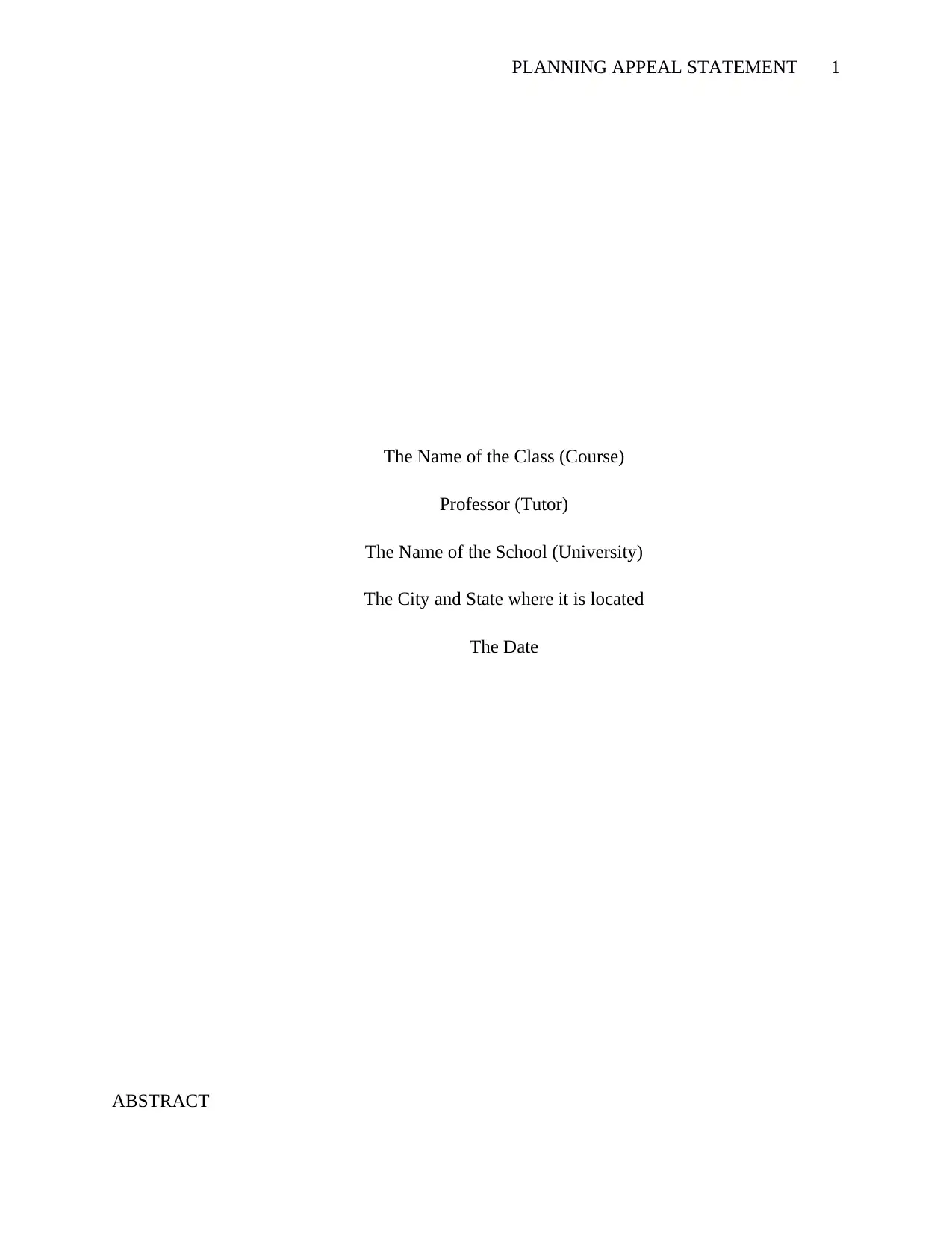
The Name of the Class (Course)
Professor (Tutor)
The Name of the School (University)
The City and State where it is located
The Date
ABSTRACT
Paraphrase This Document
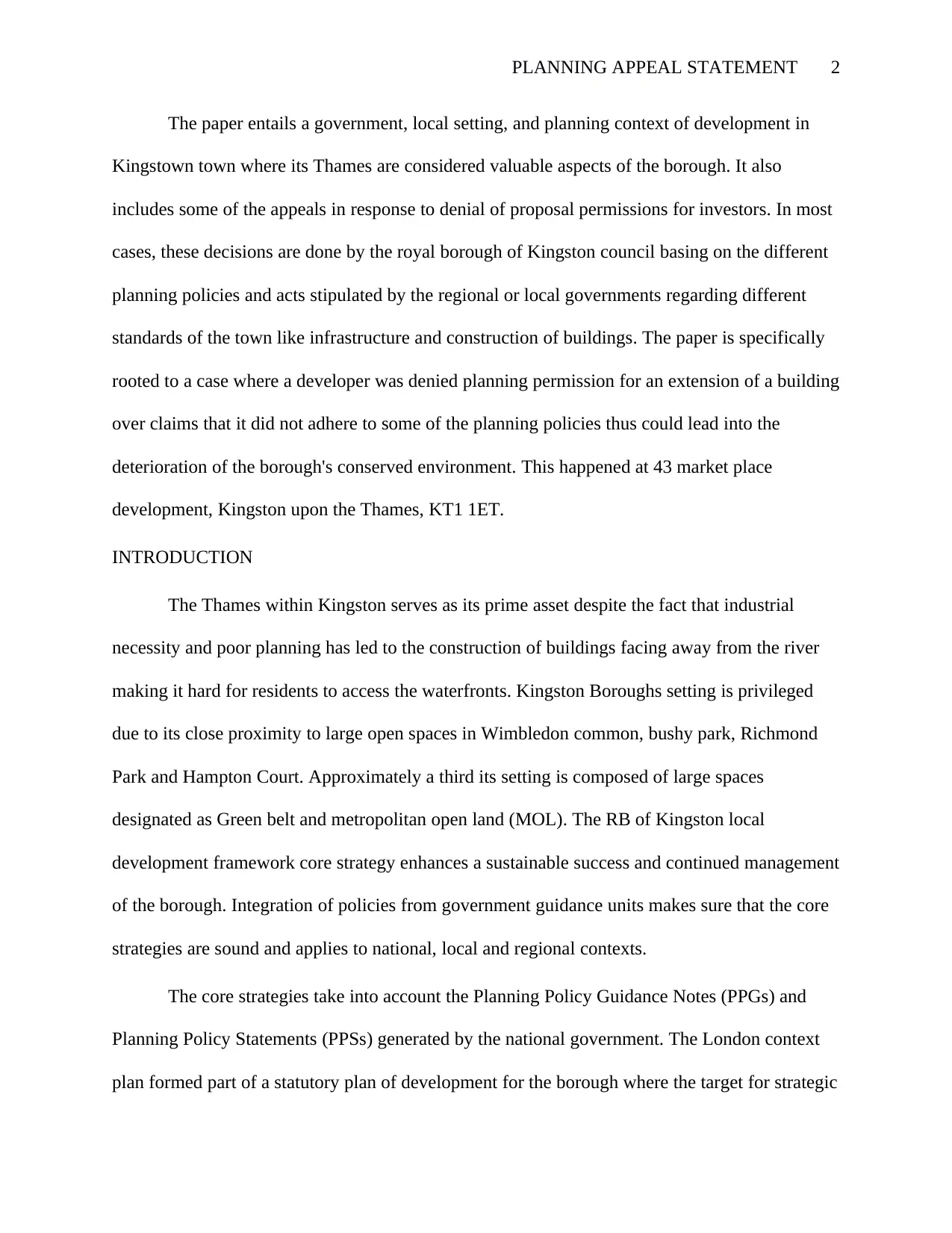
The paper entails a government, local setting, and planning context of development in
Kingstown town where its Thames are considered valuable aspects of the borough. It also
includes some of the appeals in response to denial of proposal permissions for investors. In most
cases, these decisions are done by the royal borough of Kingston council basing on the different
planning policies and acts stipulated by the regional or local governments regarding different
standards of the town like infrastructure and construction of buildings. The paper is specifically
rooted to a case where a developer was denied planning permission for an extension of a building
over claims that it did not adhere to some of the planning policies thus could lead into the
deterioration of the borough's conserved environment. This happened at 43 market place
development, Kingston upon the Thames, KT1 1ET.
INTRODUCTION
The Thames within Kingston serves as its prime asset despite the fact that industrial
necessity and poor planning has led to the construction of buildings facing away from the river
making it hard for residents to access the waterfronts. Kingston Boroughs setting is privileged
due to its close proximity to large open spaces in Wimbledon common, bushy park, Richmond
Park and Hampton Court. Approximately a third its setting is composed of large spaces
designated as Green belt and metropolitan open land (MOL). The RB of Kingston local
development framework core strategy enhances a sustainable success and continued management
of the borough. Integration of policies from government guidance units makes sure that the core
strategies are sound and applies to national, local and regional contexts.
The core strategies take into account the Planning Policy Guidance Notes (PPGs) and
Planning Policy Statements (PPSs) generated by the national government. The London context
plan formed part of a statutory plan of development for the borough where the target for strategic
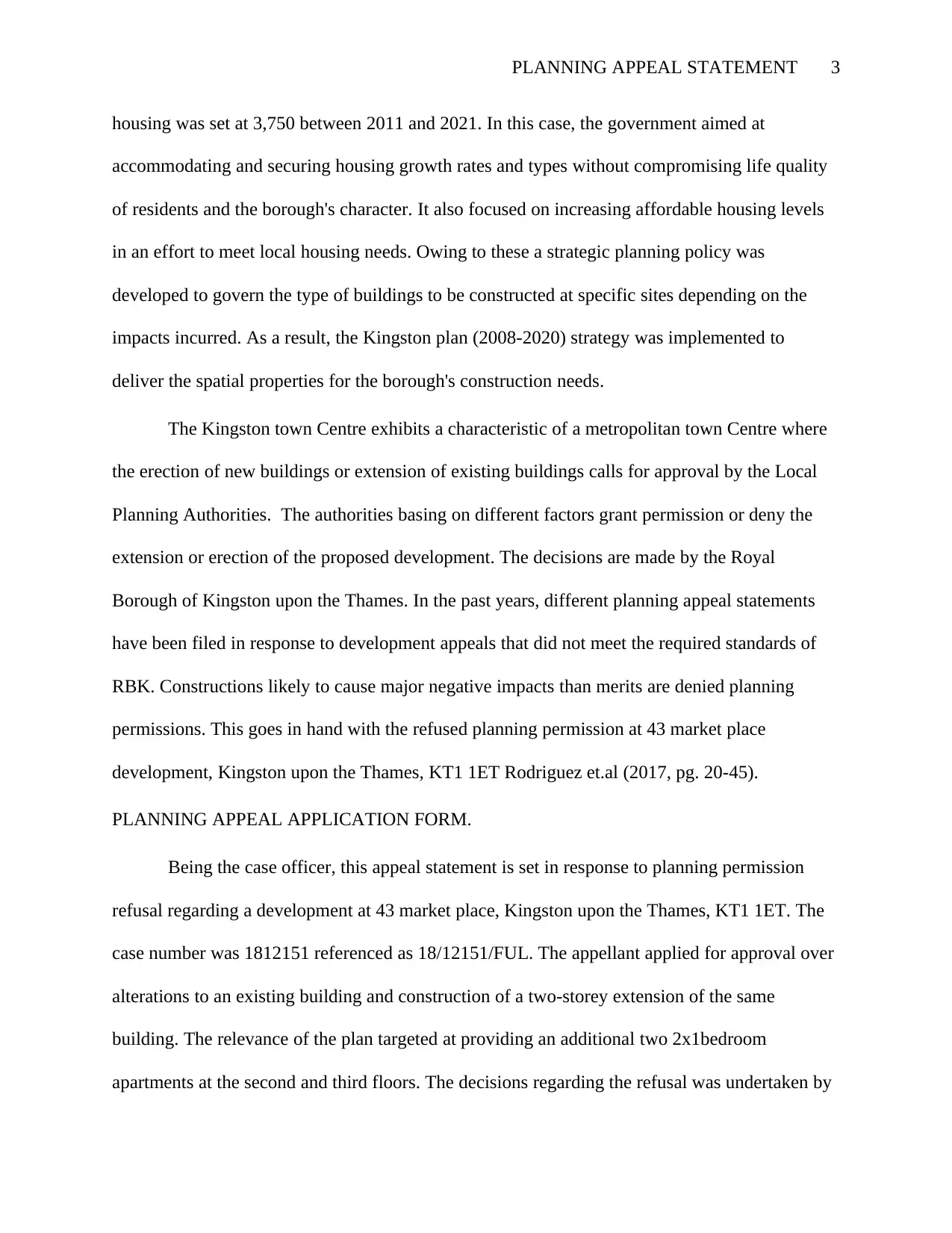
housing was set at 3,750 between 2011 and 2021. In this case, the government aimed at
accommodating and securing housing growth rates and types without compromising life quality
of residents and the borough's character. It also focused on increasing affordable housing levels
in an effort to meet local housing needs. Owing to these a strategic planning policy was
developed to govern the type of buildings to be constructed at specific sites depending on the
impacts incurred. As a result, the Kingston plan (2008-2020) strategy was implemented to
deliver the spatial properties for the borough's construction needs.
The Kingston town Centre exhibits a characteristic of a metropolitan town Centre where
the erection of new buildings or extension of existing buildings calls for approval by the Local
Planning Authorities. The authorities basing on different factors grant permission or deny the
extension or erection of the proposed development. The decisions are made by the Royal
Borough of Kingston upon the Thames. In the past years, different planning appeal statements
have been filed in response to development appeals that did not meet the required standards of
RBK. Constructions likely to cause major negative impacts than merits are denied planning
permissions. This goes in hand with the refused planning permission at 43 market place
development, Kingston upon the Thames, KT1 1ET Rodriguez et.al (2017, pg. 20-45).
PLANNING APPEAL APPLICATION FORM.
Being the case officer, this appeal statement is set in response to planning permission
refusal regarding a development at 43 market place, Kingston upon the Thames, KT1 1ET. The
case number was 1812151 referenced as 18/12151/FUL. The appellant applied for approval over
alterations to an existing building and construction of a two-storey extension of the same
building. The relevance of the plan targeted at providing an additional two 2x1bedroom
apartments at the second and third floors. The decisions regarding the refusal was undertaken by
⊘ This is a preview!⊘
Do you want full access?
Subscribe today to unlock all pages.

Trusted by 1+ million students worldwide
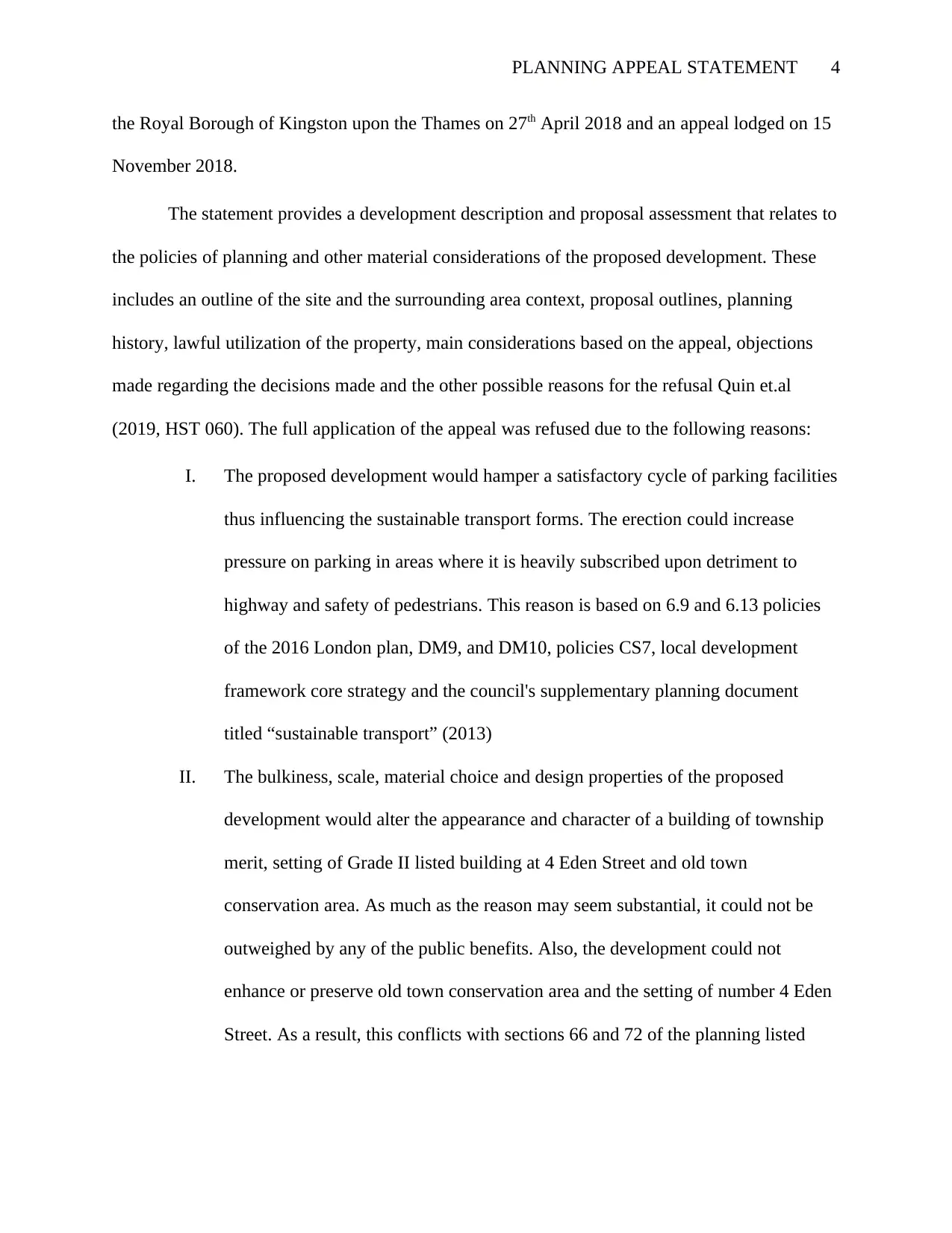
the Royal Borough of Kingston upon the Thames on 27th April 2018 and an appeal lodged on 15
November 2018.
The statement provides a development description and proposal assessment that relates to
the policies of planning and other material considerations of the proposed development. These
includes an outline of the site and the surrounding area context, proposal outlines, planning
history, lawful utilization of the property, main considerations based on the appeal, objections
made regarding the decisions made and the other possible reasons for the refusal Quin et.al
(2019, HST 060). The full application of the appeal was refused due to the following reasons:
I. The proposed development would hamper a satisfactory cycle of parking facilities
thus influencing the sustainable transport forms. The erection could increase
pressure on parking in areas where it is heavily subscribed upon detriment to
highway and safety of pedestrians. This reason is based on 6.9 and 6.13 policies
of the 2016 London plan, DM9, and DM10, policies CS7, local development
framework core strategy and the council's supplementary planning document
titled “sustainable transport” (2013)
II. The bulkiness, scale, material choice and design properties of the proposed
development would alter the appearance and character of a building of township
merit, setting of Grade II listed building at 4 Eden Street and old town
conservation area. As much as the reason may seem substantial, it could not be
outweighed by any of the public benefits. Also, the development could not
enhance or preserve old town conservation area and the setting of number 4 Eden
Street. As a result, this conflicts with sections 66 and 72 of the planning listed
Paraphrase This Document
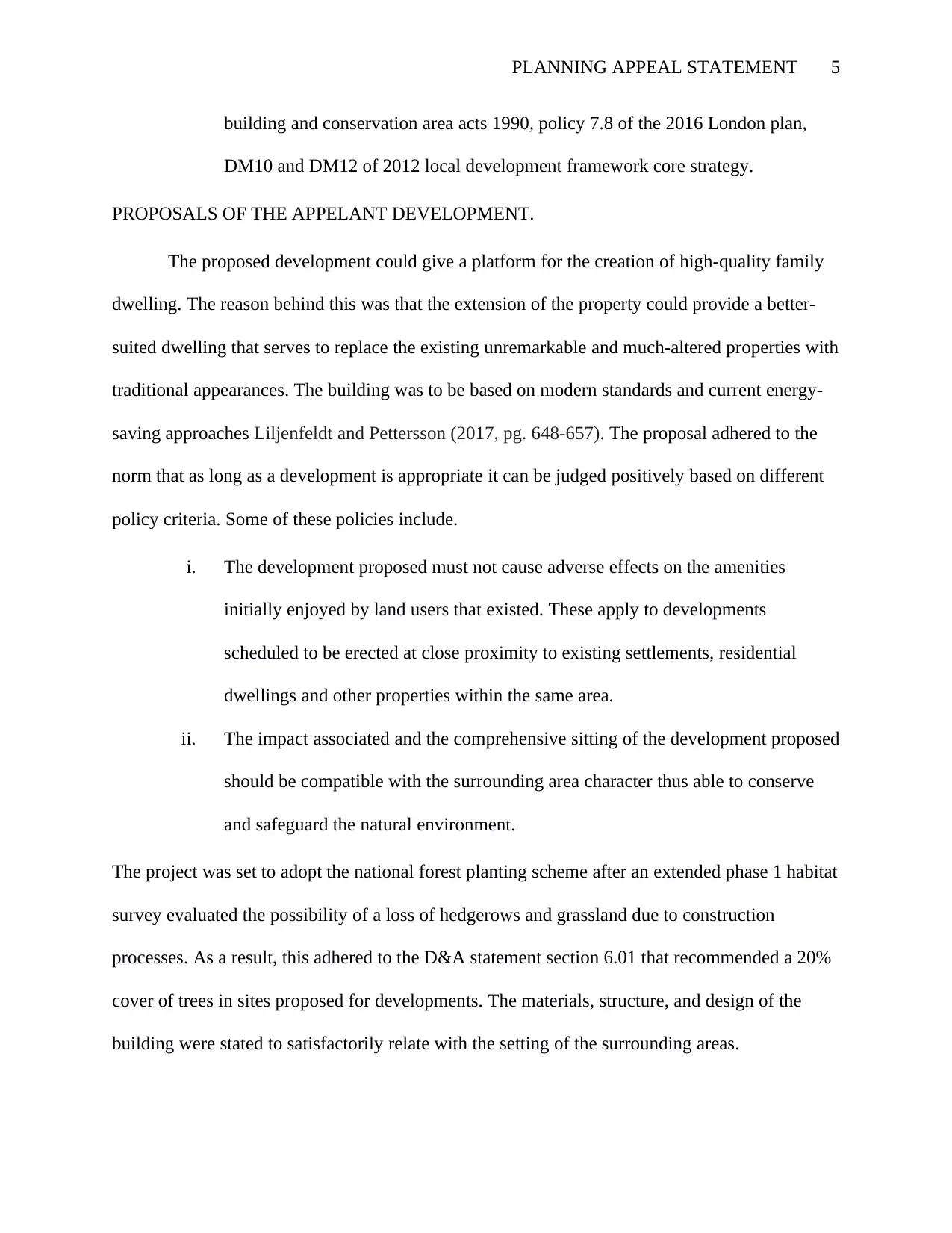
building and conservation area acts 1990, policy 7.8 of the 2016 London plan,
DM10 and DM12 of 2012 local development framework core strategy.
PROPOSALS OF THE APPELANT DEVELOPMENT.
The proposed development could give a platform for the creation of high-quality family
dwelling. The reason behind this was that the extension of the property could provide a better-
suited dwelling that serves to replace the existing unremarkable and much-altered properties with
traditional appearances. The building was to be based on modern standards and current energy-
saving approaches Liljenfeldt and Pettersson (2017, pg. 648-657). The proposal adhered to the
norm that as long as a development is appropriate it can be judged positively based on different
policy criteria. Some of these policies include.
i. The development proposed must not cause adverse effects on the amenities
initially enjoyed by land users that existed. These apply to developments
scheduled to be erected at close proximity to existing settlements, residential
dwellings and other properties within the same area.
ii. The impact associated and the comprehensive sitting of the development proposed
should be compatible with the surrounding area character thus able to conserve
and safeguard the natural environment.
The project was set to adopt the national forest planting scheme after an extended phase 1 habitat
survey evaluated the possibility of a loss of hedgerows and grassland due to construction
processes. As a result, this adhered to the D&A statement section 6.01 that recommended a 20%
cover of trees in sites proposed for developments. The materials, structure, and design of the
building were stated to satisfactorily relate with the setting of the surrounding areas.

NPPF PRESUMPTION IN FAVOUR OF SUSTAINABLE DEVELOPMENT.
Diverse laws regarding planning call for the determination of planning permission
applications in accordance with plans of development unless an alteration in materials used is
experienced. The local plan policies and the structure plan have their detailed reviews provided
by D&A statement, original planning application. As a result, certain attentions are drawn to
policy H3 review and the associated policies, BE1, NE7, and H6. The National Planning Policy
Framework always does not alter the status of the development plan despite it being the starting
point of the decision-making process. Approval of a proposed development is done when the
proposed development accords with a local plan that is up to date.
In this case, the proposed development will alter the status of the development plan over
the claims that materials used in construction could negatively impact on the nature of the
borough as a conservative area. These, therefore, is based on section 5.143 of the current local
plan where local areas must benefit due to flexibilities in their choices of housing. The various
policies stipulated in the National planning policy framework works in favor of sustainable
development. In most cases, it is viewed as golden threads stretching through the taking of
decisions to the making of plans. The plan-making process focuses on guidelines like
i. Authorities involved in local planning should seek positive opportunities that help
in meeting the area’s development requirements.
ii. Local plans should seek to attain the needs objectively assessed with enough
flexibility so as to adapt to the rapid revolution in different sectors. Any extensive
impacts associated with the act could cause a demonstrable and significant
outweighing of the benefits upon assessment against the accompanying
⊘ This is a preview!⊘
Do you want full access?
Subscribe today to unlock all pages.

Trusted by 1+ million students worldwide
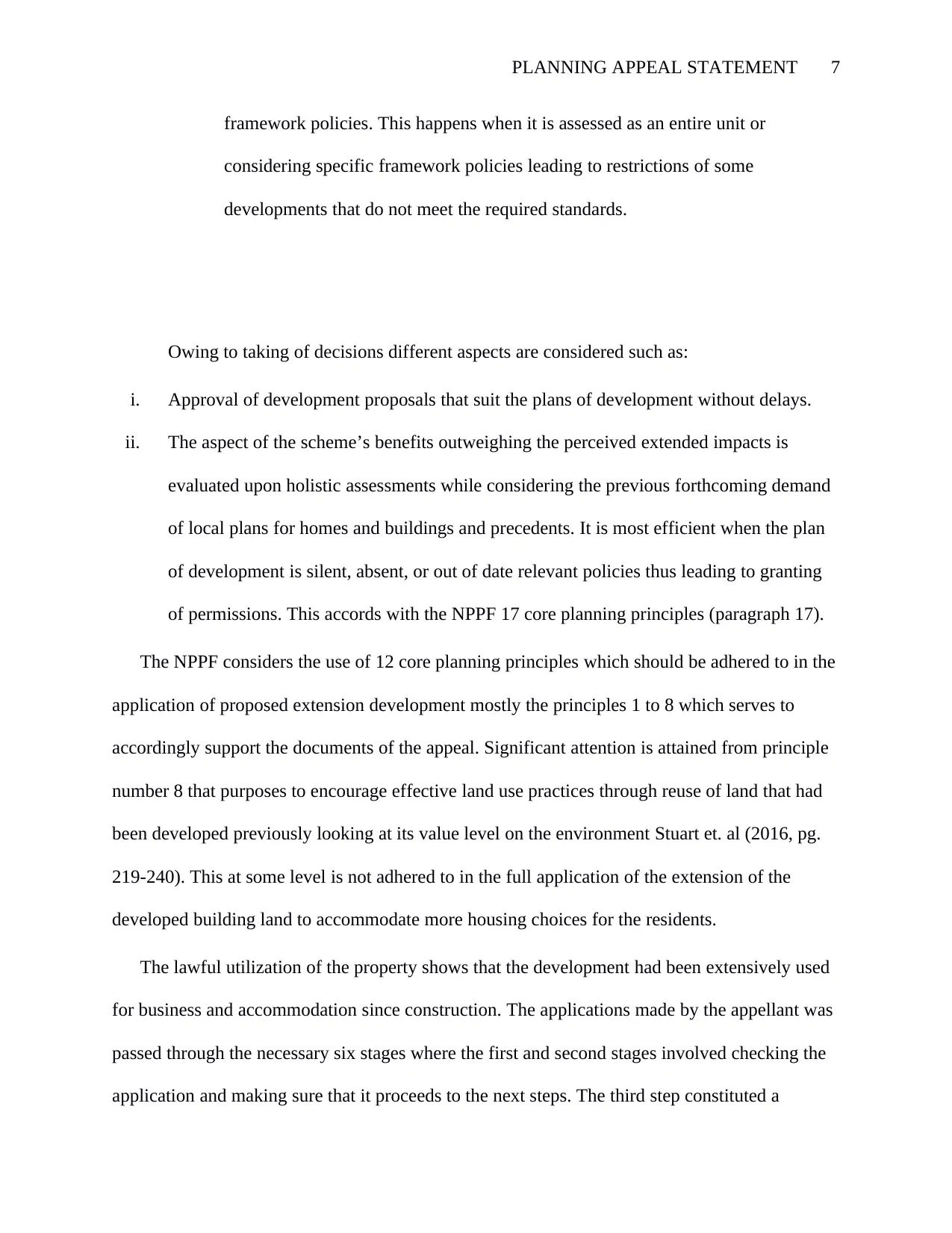
framework policies. This happens when it is assessed as an entire unit or
considering specific framework policies leading to restrictions of some
developments that do not meet the required standards.
Owing to taking of decisions different aspects are considered such as:
i. Approval of development proposals that suit the plans of development without delays.
ii. The aspect of the scheme’s benefits outweighing the perceived extended impacts is
evaluated upon holistic assessments while considering the previous forthcoming demand
of local plans for homes and buildings and precedents. It is most efficient when the plan
of development is silent, absent, or out of date relevant policies thus leading to granting
of permissions. This accords with the NPPF 17 core planning principles (paragraph 17).
The NPPF considers the use of 12 core planning principles which should be adhered to in the
application of proposed extension development mostly the principles 1 to 8 which serves to
accordingly support the documents of the appeal. Significant attention is attained from principle
number 8 that purposes to encourage effective land use practices through reuse of land that had
been developed previously looking at its value level on the environment Stuart et. al (2016, pg.
219-240). This at some level is not adhered to in the full application of the extension of the
developed building land to accommodate more housing choices for the residents.
The lawful utilization of the property shows that the development had been extensively used
for business and accommodation since construction. The applications made by the appellant was
passed through the necessary six stages where the first and second stages involved checking the
application and making sure that it proceeds to the next steps. The third step constituted a
Paraphrase This Document
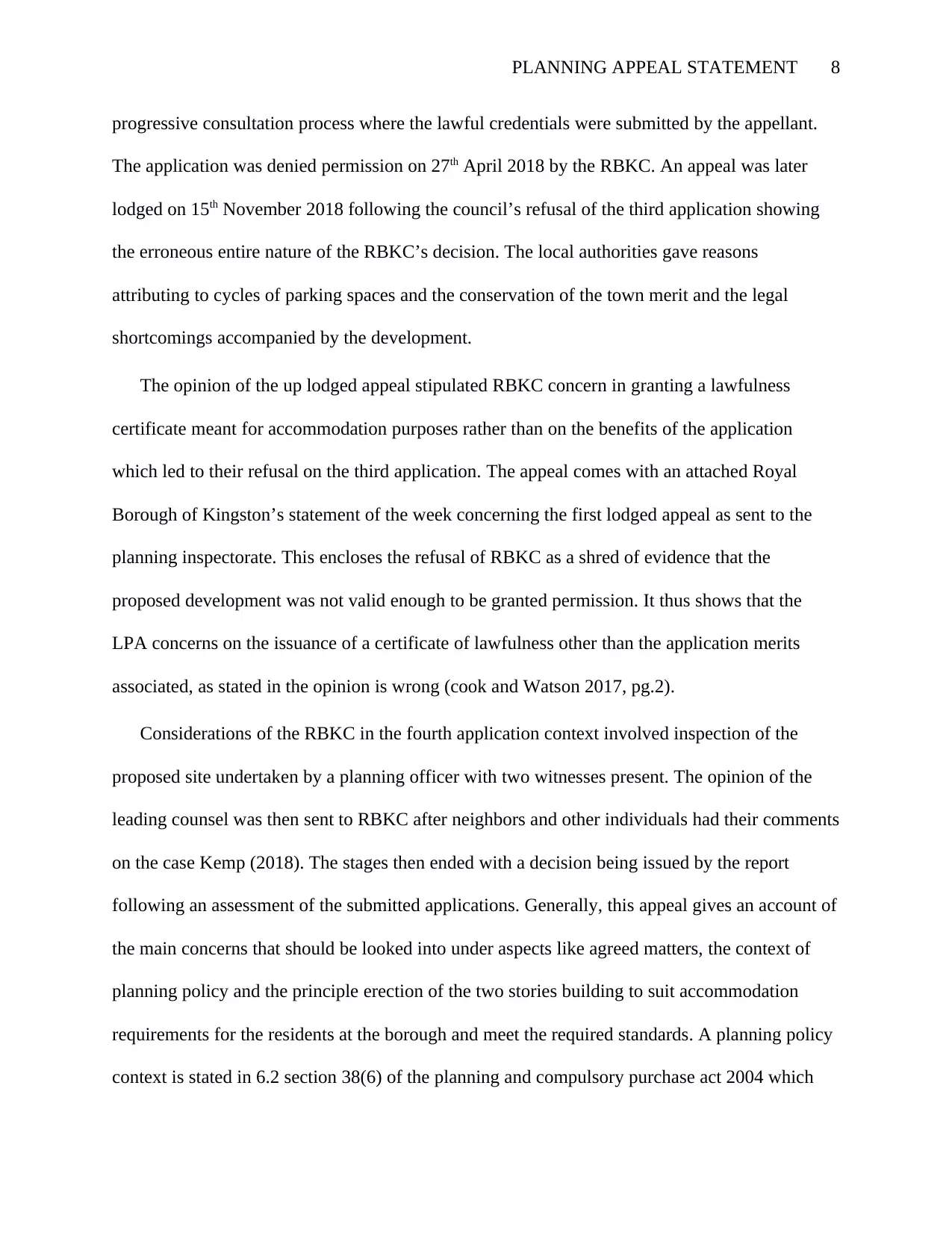
progressive consultation process where the lawful credentials were submitted by the appellant.
The application was denied permission on 27th April 2018 by the RBKC. An appeal was later
lodged on 15th November 2018 following the council’s refusal of the third application showing
the erroneous entire nature of the RBKC’s decision. The local authorities gave reasons
attributing to cycles of parking spaces and the conservation of the town merit and the legal
shortcomings accompanied by the development.
The opinion of the up lodged appeal stipulated RBKC concern in granting a lawfulness
certificate meant for accommodation purposes rather than on the benefits of the application
which led to their refusal on the third application. The appeal comes with an attached Royal
Borough of Kingston’s statement of the week concerning the first lodged appeal as sent to the
planning inspectorate. This encloses the refusal of RBKC as a shred of evidence that the
proposed development was not valid enough to be granted permission. It thus shows that the
LPA concerns on the issuance of a certificate of lawfulness other than the application merits
associated, as stated in the opinion is wrong (cook and Watson 2017, pg.2).
Considerations of the RBKC in the fourth application context involved inspection of the
proposed site undertaken by a planning officer with two witnesses present. The opinion of the
leading counsel was then sent to RBKC after neighbors and other individuals had their comments
on the case Kemp (2018). The stages then ended with a decision being issued by the report
following an assessment of the submitted applications. Generally, this appeal gives an account of
the main concerns that should be looked into under aspects like agreed matters, the context of
planning policy and the principle erection of the two stories building to suit accommodation
requirements for the residents at the borough and meet the required standards. A planning policy
context is stated in 6.2 section 38(6) of the planning and compulsory purchase act 2004 which
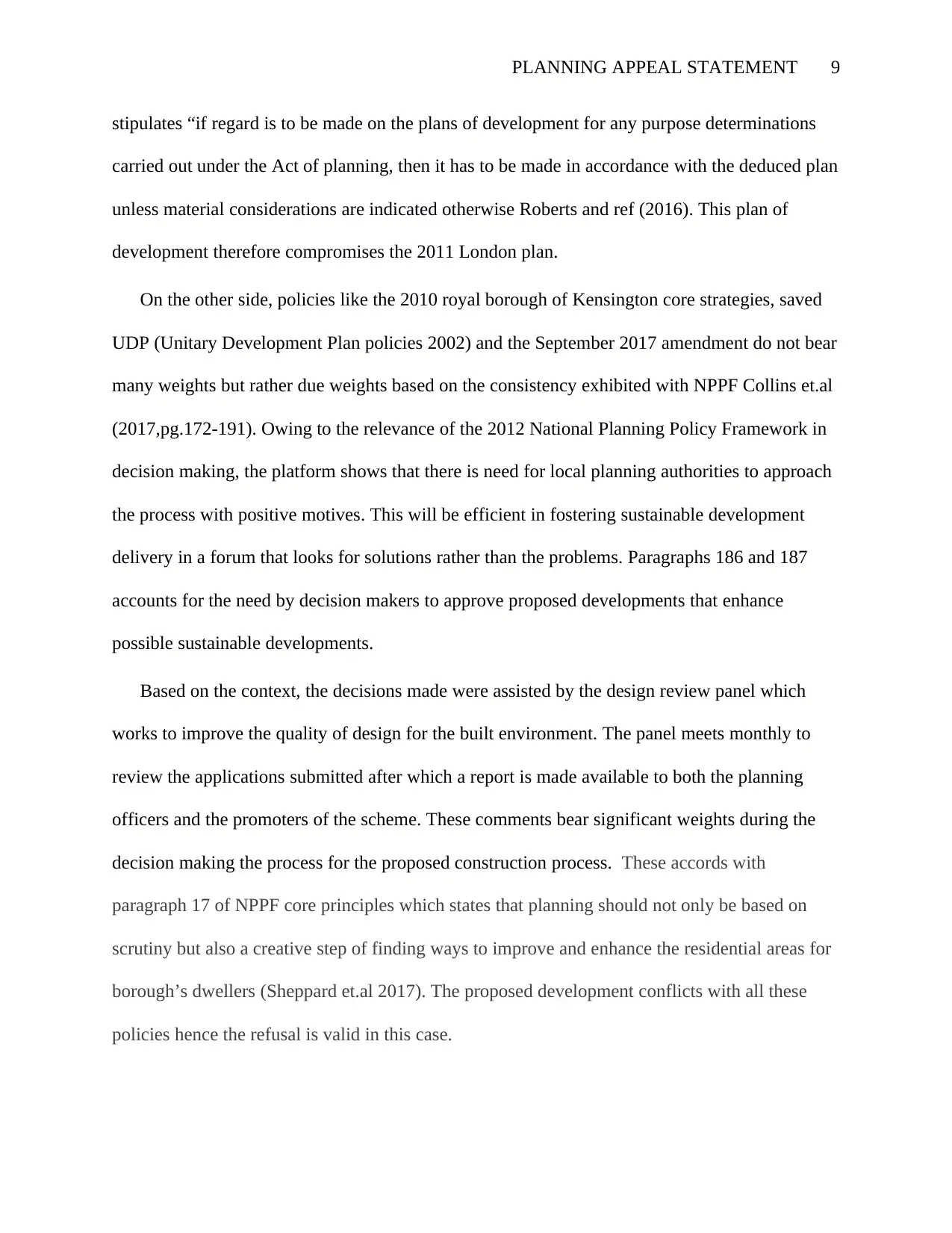
stipulates “if regard is to be made on the plans of development for any purpose determinations
carried out under the Act of planning, then it has to be made in accordance with the deduced plan
unless material considerations are indicated otherwise Roberts and ref (2016). This plan of
development therefore compromises the 2011 London plan.
On the other side, policies like the 2010 royal borough of Kensington core strategies, saved
UDP (Unitary Development Plan policies 2002) and the September 2017 amendment do not bear
many weights but rather due weights based on the consistency exhibited with NPPF Collins et.al
(2017,pg.172-191). Owing to the relevance of the 2012 National Planning Policy Framework in
decision making, the platform shows that there is need for local planning authorities to approach
the process with positive motives. This will be efficient in fostering sustainable development
delivery in a forum that looks for solutions rather than the problems. Paragraphs 186 and 187
accounts for the need by decision makers to approve proposed developments that enhance
possible sustainable developments.
Based on the context, the decisions made were assisted by the design review panel which
works to improve the quality of design for the built environment. The panel meets monthly to
review the applications submitted after which a report is made available to both the planning
officers and the promoters of the scheme. These comments bear significant weights during the
decision making the process for the proposed construction process. These accords with
paragraph 17 of NPPF core principles which states that planning should not only be based on
scrutiny but also a creative step of finding ways to improve and enhance the residential areas for
borough’s dwellers (Sheppard et.al 2017). The proposed development conflicts with all these
policies hence the refusal is valid in this case.
⊘ This is a preview!⊘
Do you want full access?
Subscribe today to unlock all pages.

Trusted by 1+ million students worldwide
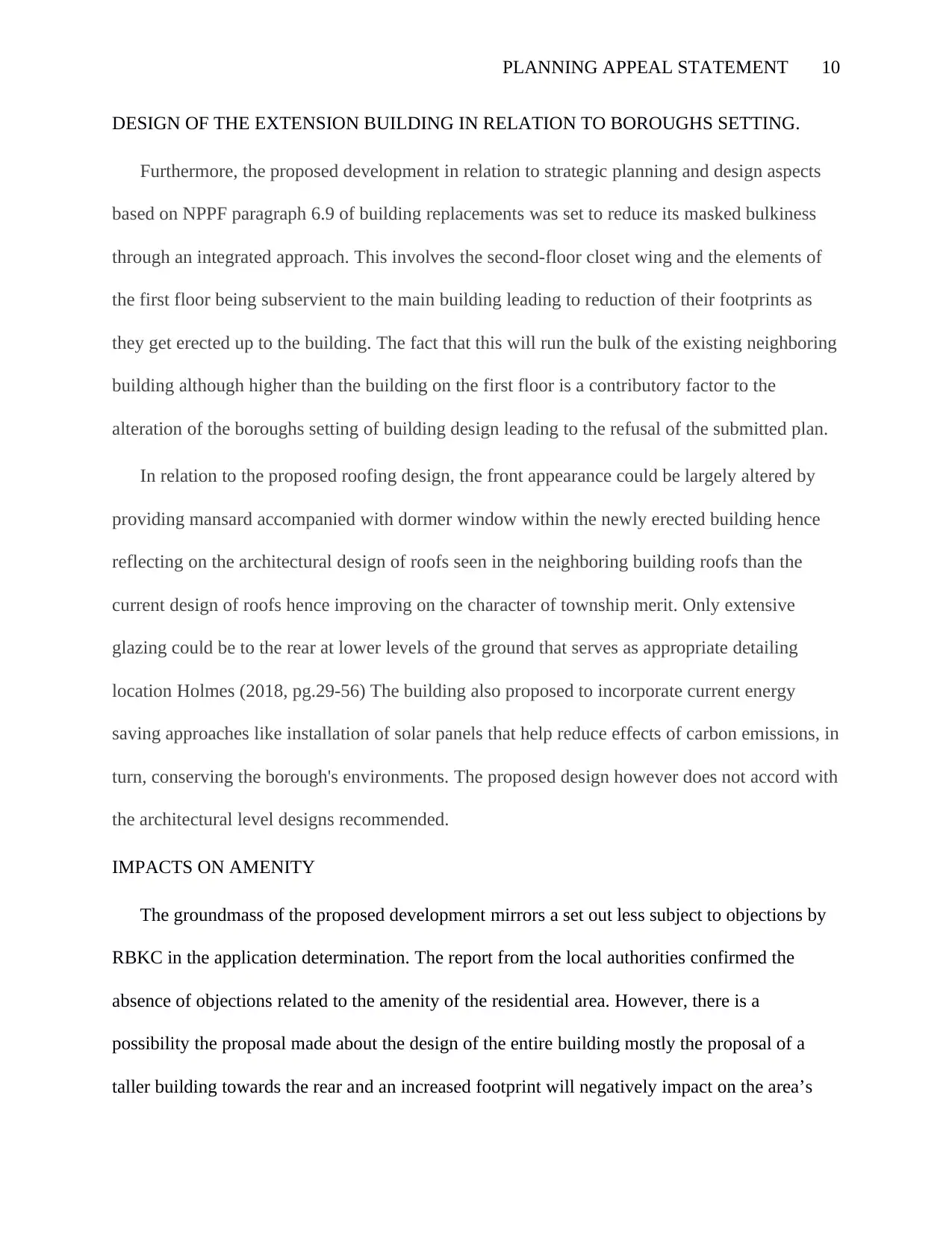
DESIGN OF THE EXTENSION BUILDING IN RELATION TO BOROUGHS SETTING.
Furthermore, the proposed development in relation to strategic planning and design aspects
based on NPPF paragraph 6.9 of building replacements was set to reduce its masked bulkiness
through an integrated approach. This involves the second-floor closet wing and the elements of
the first floor being subservient to the main building leading to reduction of their footprints as
they get erected up to the building. The fact that this will run the bulk of the existing neighboring
building although higher than the building on the first floor is a contributory factor to the
alteration of the boroughs setting of building design leading to the refusal of the submitted plan.
In relation to the proposed roofing design, the front appearance could be largely altered by
providing mansard accompanied with dormer window within the newly erected building hence
reflecting on the architectural design of roofs seen in the neighboring building roofs than the
current design of roofs hence improving on the character of township merit. Only extensive
glazing could be to the rear at lower levels of the ground that serves as appropriate detailing
location Holmes (2018, pg.29-56) The building also proposed to incorporate current energy
saving approaches like installation of solar panels that help reduce effects of carbon emissions, in
turn, conserving the borough's environments. The proposed design however does not accord with
the architectural level designs recommended.
IMPACTS ON AMENITY
The groundmass of the proposed development mirrors a set out less subject to objections by
RBKC in the application determination. The report from the local authorities confirmed the
absence of objections related to the amenity of the residential area. However, there is a
possibility the proposal made about the design of the entire building mostly the proposal of a
taller building towards the rear and an increased footprint will negatively impact on the area’s
Paraphrase This Document
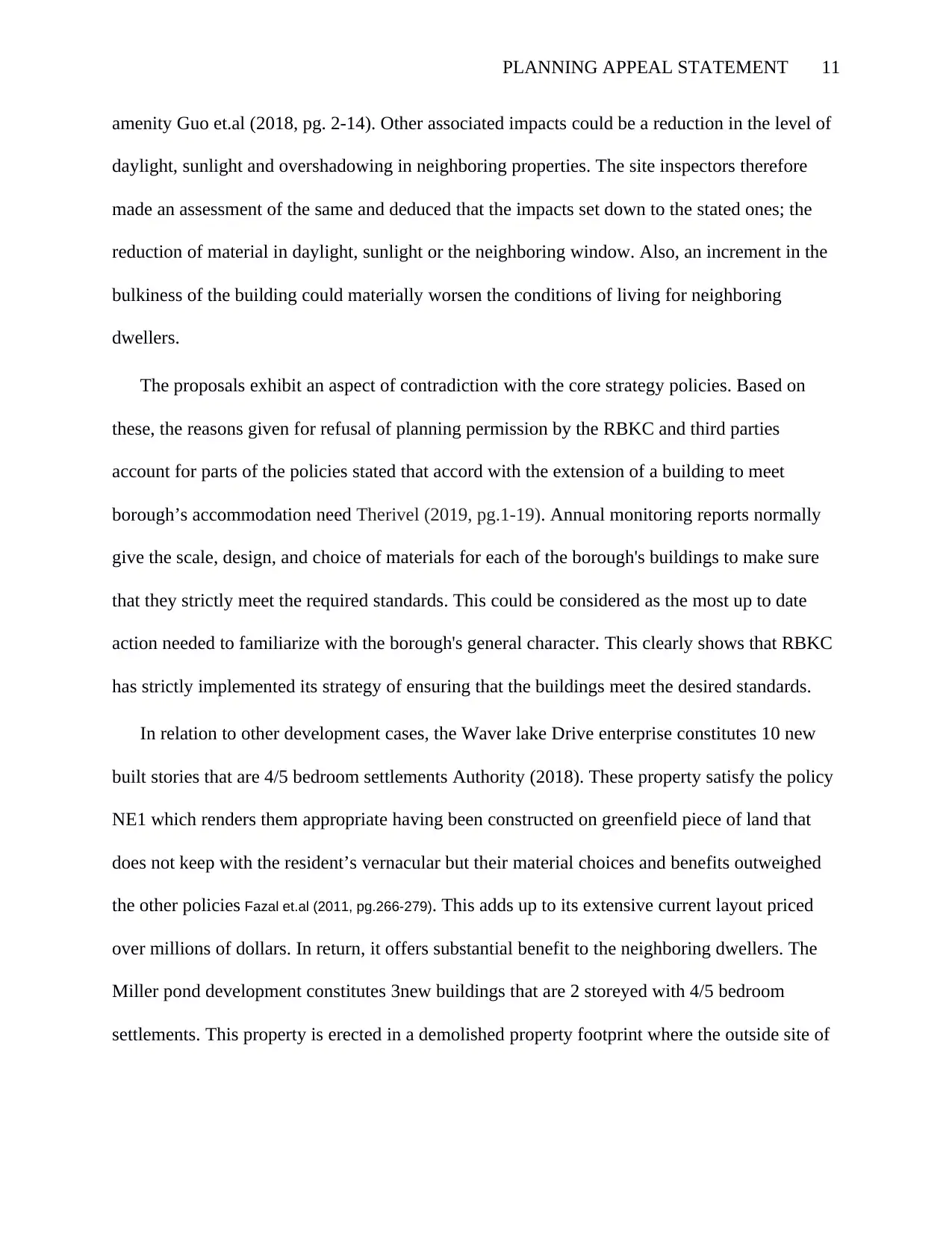
amenity Guo et.al (2018, pg. 2-14). Other associated impacts could be a reduction in the level of
daylight, sunlight and overshadowing in neighboring properties. The site inspectors therefore
made an assessment of the same and deduced that the impacts set down to the stated ones; the
reduction of material in daylight, sunlight or the neighboring window. Also, an increment in the
bulkiness of the building could materially worsen the conditions of living for neighboring
dwellers.
The proposals exhibit an aspect of contradiction with the core strategy policies. Based on
these, the reasons given for refusal of planning permission by the RBKC and third parties
account for parts of the policies stated that accord with the extension of a building to meet
borough’s accommodation need Therivel (2019, pg.1-19). Annual monitoring reports normally
give the scale, design, and choice of materials for each of the borough's buildings to make sure
that they strictly meet the required standards. This could be considered as the most up to date
action needed to familiarize with the borough's general character. This clearly shows that RBKC
has strictly implemented its strategy of ensuring that the buildings meet the desired standards.
In relation to other development cases, the Waver lake Drive enterprise constitutes 10 new
built stories that are 4/5 bedroom settlements Authority (2018). These property satisfy the policy
NE1 which renders them appropriate having been constructed on greenfield piece of land that
does not keep with the resident’s vernacular but their material choices and benefits outweighed
the other policies Fazal et.al (2011, pg.266-279). This adds up to its extensive current layout priced
over millions of dollars. In return, it offers substantial benefit to the neighboring dwellers. The
Miller pond development constitutes 3new buildings that are 2 storeyed with 4/5 bedroom
settlements. This property is erected in a demolished property footprint where the outside site of
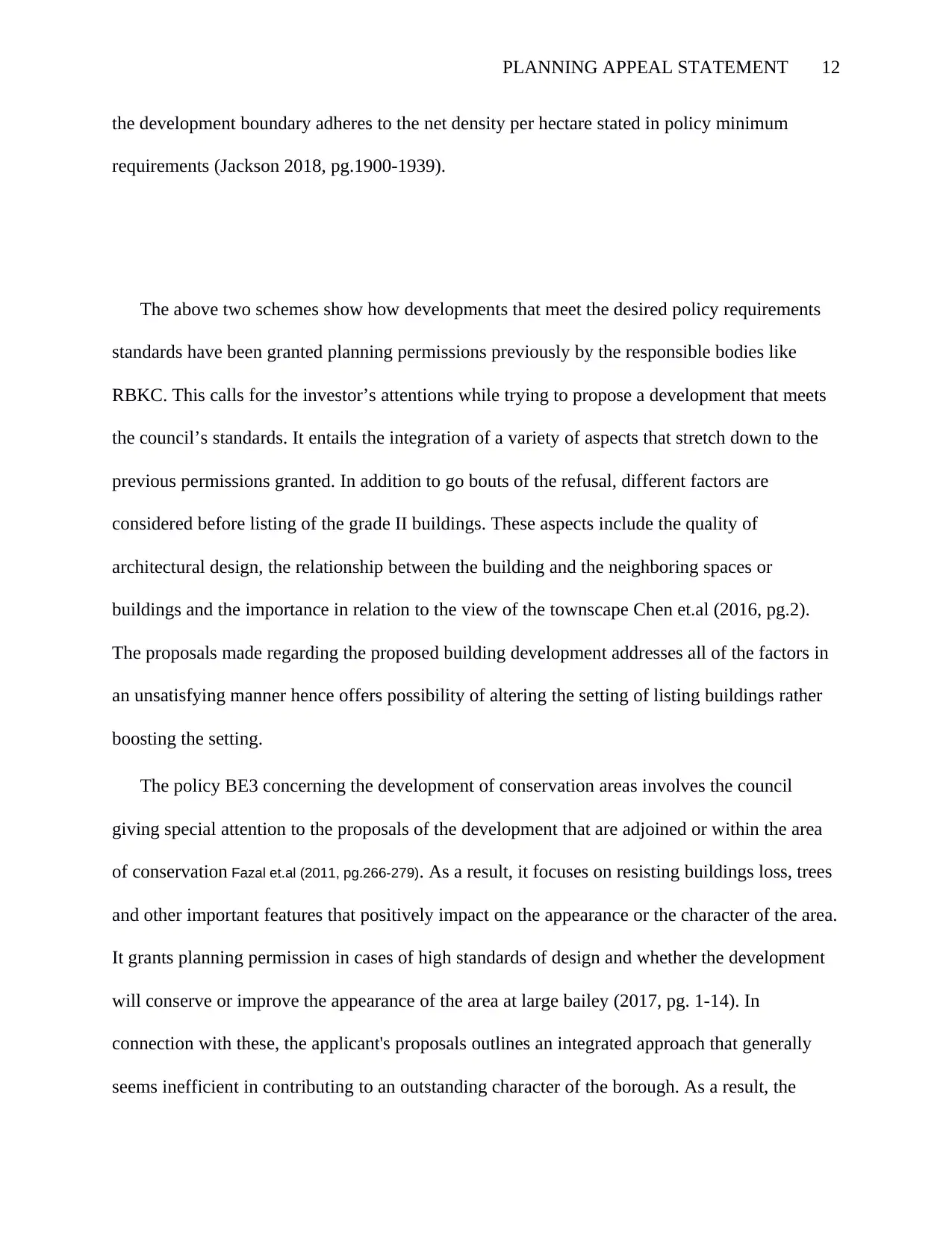
the development boundary adheres to the net density per hectare stated in policy minimum
requirements (Jackson 2018, pg.1900-1939).
The above two schemes show how developments that meet the desired policy requirements
standards have been granted planning permissions previously by the responsible bodies like
RBKC. This calls for the investor’s attentions while trying to propose a development that meets
the council’s standards. It entails the integration of a variety of aspects that stretch down to the
previous permissions granted. In addition to go bouts of the refusal, different factors are
considered before listing of the grade II buildings. These aspects include the quality of
architectural design, the relationship between the building and the neighboring spaces or
buildings and the importance in relation to the view of the townscape Chen et.al (2016, pg.2).
The proposals made regarding the proposed building development addresses all of the factors in
an unsatisfying manner hence offers possibility of altering the setting of listing buildings rather
boosting the setting.
The policy BE3 concerning the development of conservation areas involves the council
giving special attention to the proposals of the development that are adjoined or within the area
of conservation Fazal et.al (2011, pg.266-279). As a result, it focuses on resisting buildings loss, trees
and other important features that positively impact on the appearance or the character of the area.
It grants planning permission in cases of high standards of design and whether the development
will conserve or improve the appearance of the area at large bailey (2017, pg. 1-14). In
connection with these, the applicant's proposals outlines an integrated approach that generally
seems inefficient in contributing to an outstanding character of the borough. As a result, the
⊘ This is a preview!⊘
Do you want full access?
Subscribe today to unlock all pages.

Trusted by 1+ million students worldwide
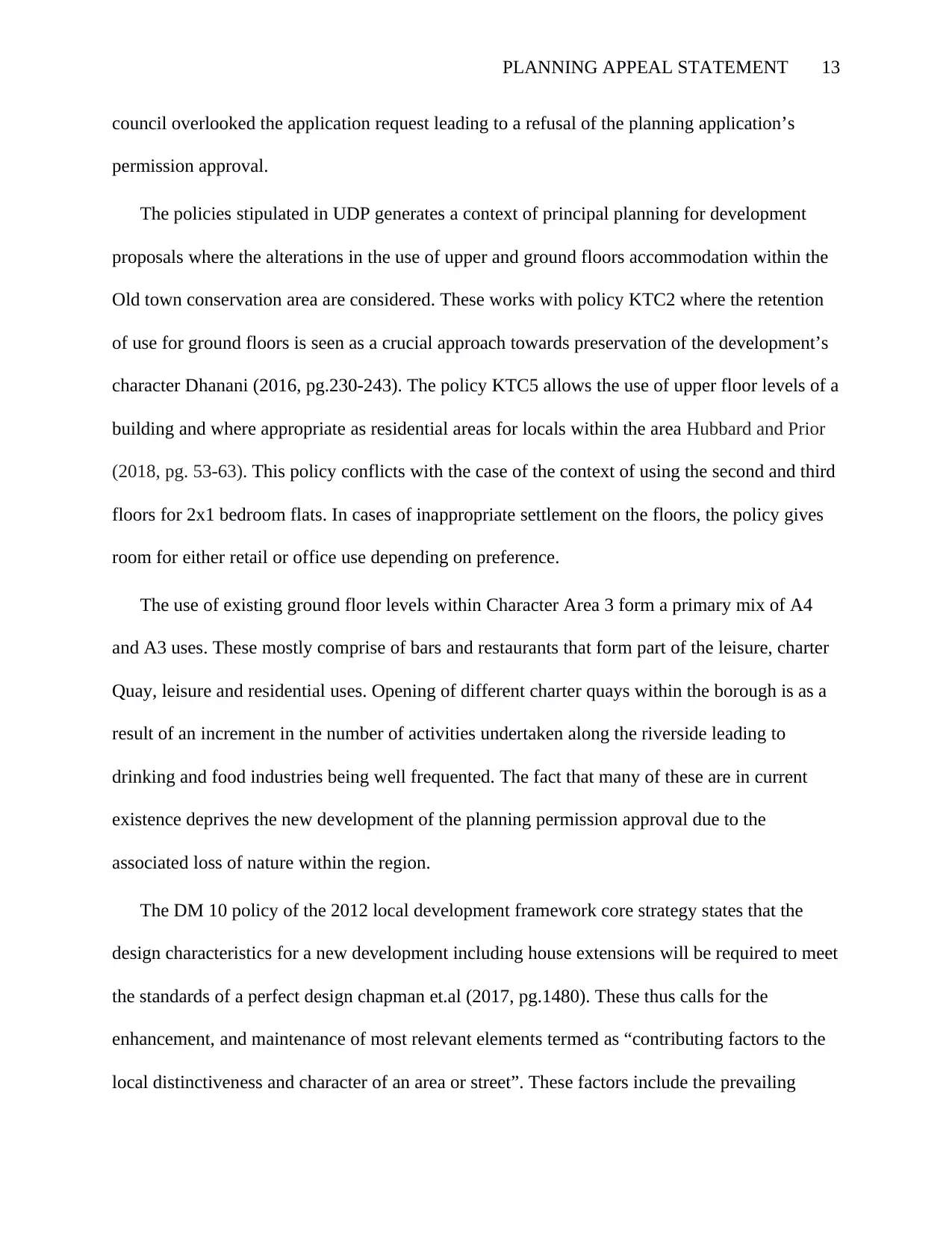
council overlooked the application request leading to a refusal of the planning application’s
permission approval.
The policies stipulated in UDP generates a context of principal planning for development
proposals where the alterations in the use of upper and ground floors accommodation within the
Old town conservation area are considered. These works with policy KTC2 where the retention
of use for ground floors is seen as a crucial approach towards preservation of the development’s
character Dhanani (2016, pg.230-243). The policy KTC5 allows the use of upper floor levels of a
building and where appropriate as residential areas for locals within the area Hubbard and Prior
(2018, pg. 53-63). This policy conflicts with the case of the context of using the second and third
floors for 2x1 bedroom flats. In cases of inappropriate settlement on the floors, the policy gives
room for either retail or office use depending on preference.
The use of existing ground floor levels within Character Area 3 form a primary mix of A4
and A3 uses. These mostly comprise of bars and restaurants that form part of the leisure, charter
Quay, leisure and residential uses. Opening of different charter quays within the borough is as a
result of an increment in the number of activities undertaken along the riverside leading to
drinking and food industries being well frequented. The fact that many of these are in current
existence deprives the new development of the planning permission approval due to the
associated loss of nature within the region.
The DM 10 policy of the 2012 local development framework core strategy states that the
design characteristics for a new development including house extensions will be required to meet
the standards of a perfect design chapman et.al (2017, pg.1480). These thus calls for the
enhancement, and maintenance of most relevant elements termed as “contributing factors to the
local distinctiveness and character of an area or street”. These factors include the prevailing
Paraphrase This Document

typology of development, types, occupancy and sizes of houses, prevailing surrounding area
density, height, layout, form including rooftops, the scale and the massing, landscape features
and setting, format and width of the plot involving the space between buildings, window formats,
materials used in building and the detailed design elevations of the building Hart and Hollander
(2018, pg. 1-13). The proposal of the plan was also set to ensure that there is an adequate
communal or private amenity space. This included engaging requirements of construction with
sustainable design as stated in the policies. However, almost all of the proposals stated do not
meet the requirements of this policy.
On the other side, the DM 12 policy stated in the 2012 core strategy framework gives an
expectation for the new development plan. This includes the conservation of features like trees
that contribute to the overall character of the area preserved under the Tree Preservation Orders.
Jenkins (2018, pg.73-83). The council requires replacement of two specimens upon loss of a
single feature during the development process in an effort to maintain the nature of the borough
Bhide (2017). As a result, the council denies planning permissions to developments likely to
greatly impact on the leafy character of Kingston without provision of appropriate replacement
procedures. The council is also set to accord with the elements that exhibit local relevance and
special interests throughout the form, layout, scale, area, and scape and site considerations.
Furthermore, the policy gives room for seeking improvement and conservation measures of the
built and natural environment that contribute to the character of the borough's setting. Basing on
the applicant's scenario, an extension of a building is likely to greatly impact on the character of
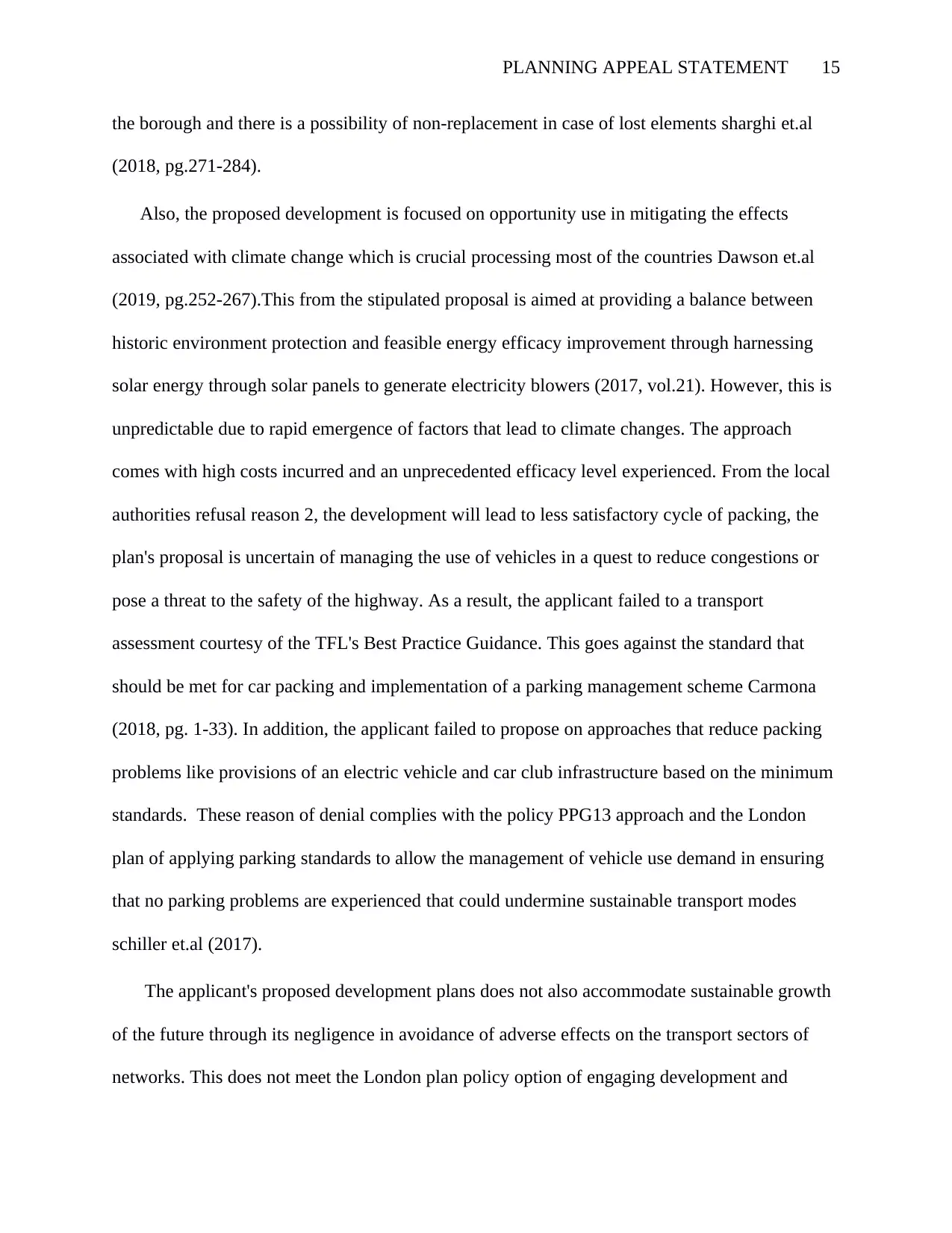
the borough and there is a possibility of non-replacement in case of lost elements sharghi et.al
(2018, pg.271-284).
Also, the proposed development is focused on opportunity use in mitigating the effects
associated with climate change which is crucial processing most of the countries Dawson et.al
(2019, pg.252-267).This from the stipulated proposal is aimed at providing a balance between
historic environment protection and feasible energy efficacy improvement through harnessing
solar energy through solar panels to generate electricity blowers (2017, vol.21). However, this is
unpredictable due to rapid emergence of factors that lead to climate changes. The approach
comes with high costs incurred and an unprecedented efficacy level experienced. From the local
authorities refusal reason 2, the development will lead to less satisfactory cycle of packing, the
plan's proposal is uncertain of managing the use of vehicles in a quest to reduce congestions or
pose a threat to the safety of the highway. As a result, the applicant failed to a transport
assessment courtesy of the TFL's Best Practice Guidance. This goes against the standard that
should be met for car packing and implementation of a parking management scheme Carmona
(2018, pg. 1-33). In addition, the applicant failed to propose on approaches that reduce packing
problems like provisions of an electric vehicle and car club infrastructure based on the minimum
standards. These reason of denial complies with the policy PPG13 approach and the London
plan of applying parking standards to allow the management of vehicle use demand in ensuring
that no parking problems are experienced that could undermine sustainable transport modes
schiller et.al (2017).
The applicant's proposed development plans does not also accommodate sustainable growth
of the future through its negligence in avoidance of adverse effects on the transport sectors of
networks. This does not meet the London plan policy option of engaging development and
⊘ This is a preview!⊘
Do you want full access?
Subscribe today to unlock all pages.

Trusted by 1+ million students worldwide
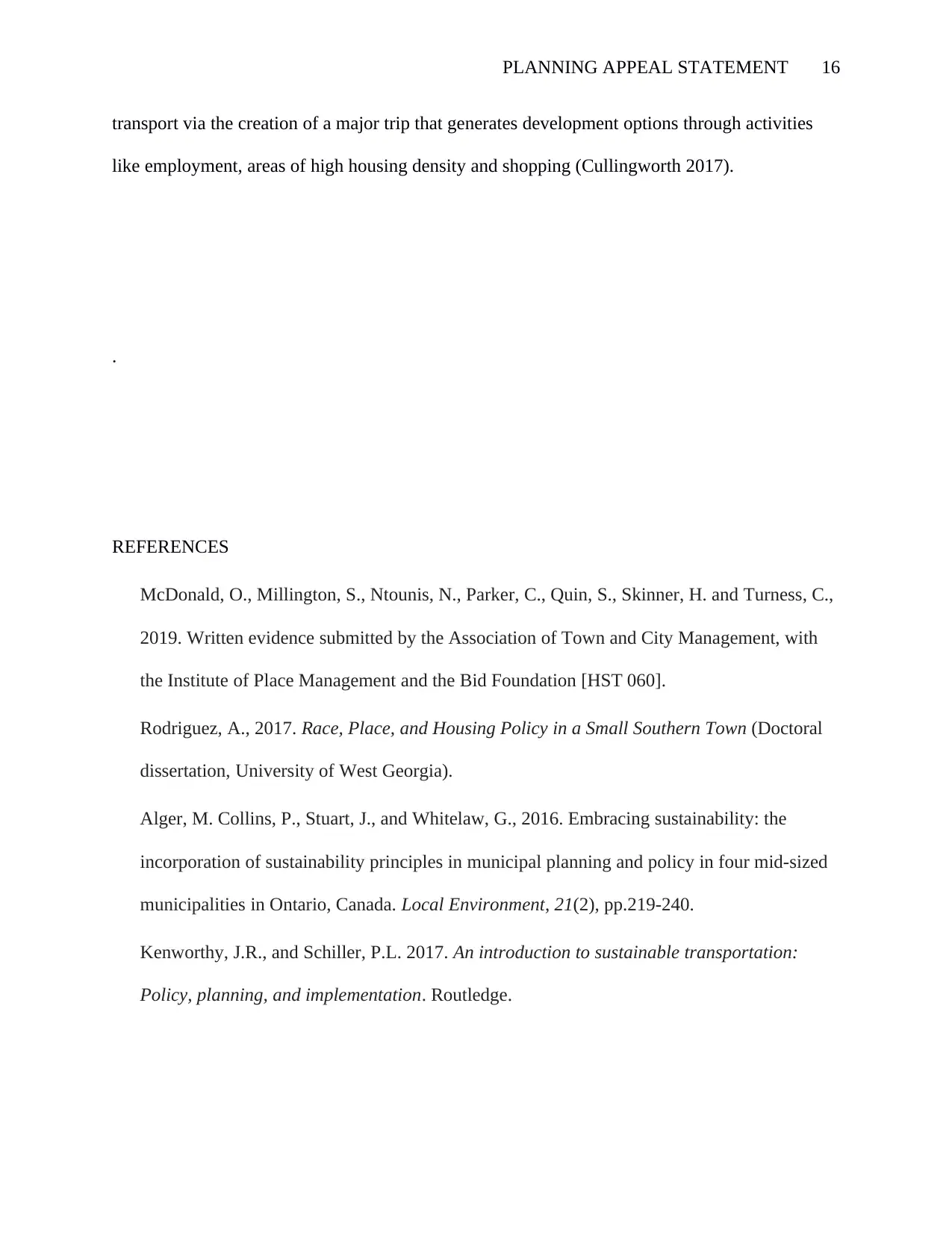
transport via the creation of a major trip that generates development options through activities
like employment, areas of high housing density and shopping (Cullingworth 2017).
.
REFERENCES
McDonald, O., Millington, S., Ntounis, N., Parker, C., Quin, S., Skinner, H. and Turness, C.,
2019. Written evidence submitted by the Association of Town and City Management, with
the Institute of Place Management and the Bid Foundation [HST 060].
Rodriguez, A., 2017. Race, Place, and Housing Policy in a Small Southern Town (Doctoral
dissertation, University of West Georgia).
Alger, M. Collins, P., Stuart, J., and Whitelaw, G., 2016. Embracing sustainability: the
incorporation of sustainability principles in municipal planning and policy in four mid-sized
municipalities in Ontario, Canada. Local Environment, 21(2), pp.219-240.
Kenworthy, J.R., and Schiller, P.L. 2017. An introduction to sustainable transportation:
Policy, planning, and implementation. Routledge.
Paraphrase This Document
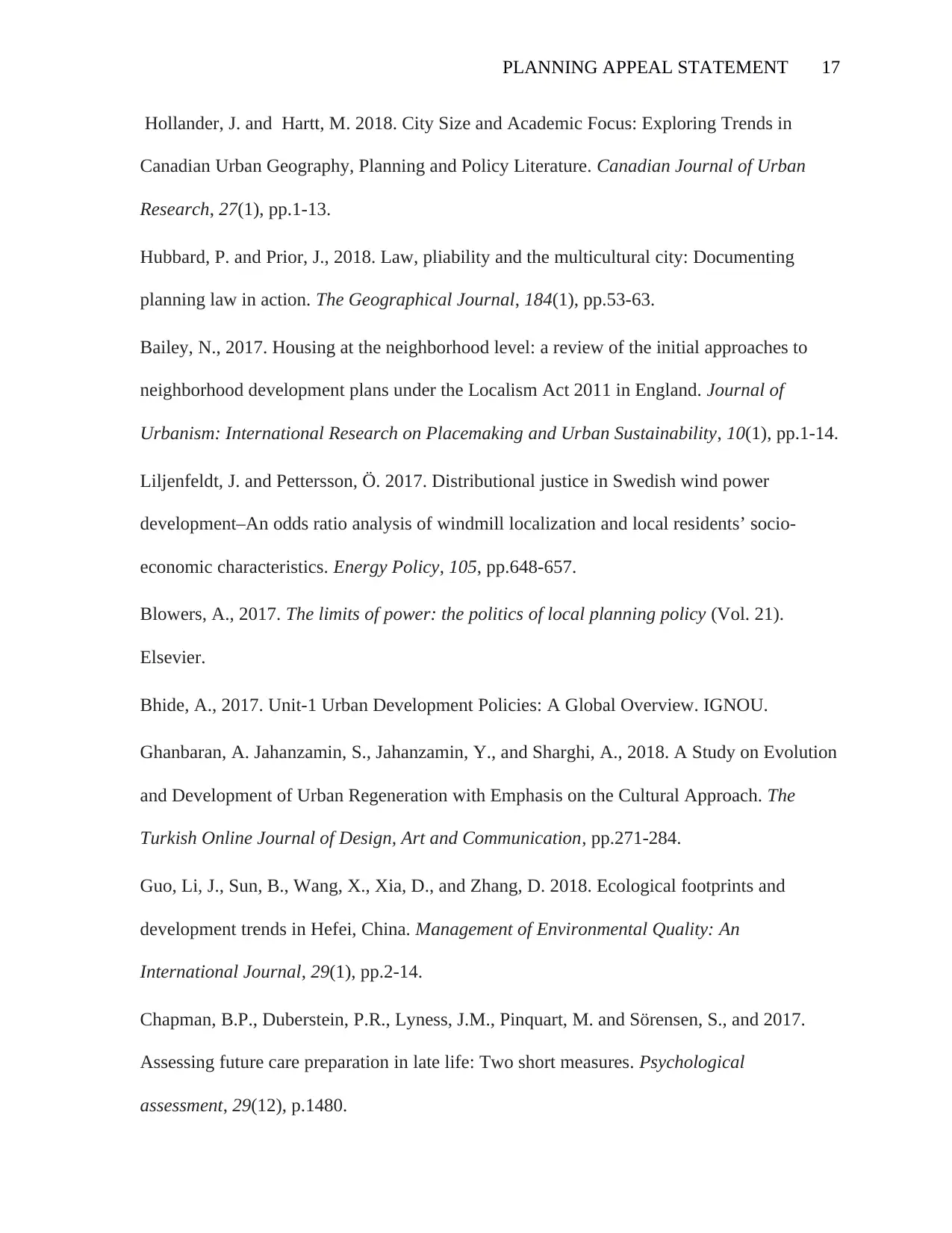
Hollander, J. and Hartt, M. 2018. City Size and Academic Focus: Exploring Trends in
Canadian Urban Geography, Planning and Policy Literature. Canadian Journal of Urban
Research, 27(1), pp.1-13.
Hubbard, P. and Prior, J., 2018. Law, pliability and the multicultural city: Documenting
planning law in action. The Geographical Journal, 184(1), pp.53-63.
Bailey, N., 2017. Housing at the neighborhood level: a review of the initial approaches to
neighborhood development plans under the Localism Act 2011 in England. Journal of
Urbanism: International Research on Placemaking and Urban Sustainability, 10(1), pp.1-14.
Liljenfeldt, J. and Pettersson, Ö. 2017. Distributional justice in Swedish wind power
development–An odds ratio analysis of windmill localization and local residents’ socio-
economic characteristics. Energy Policy, 105, pp.648-657.
Blowers, A., 2017. The limits of power: the politics of local planning policy (Vol. 21).
Elsevier.
Bhide, A., 2017. Unit-1 Urban Development Policies: A Global Overview. IGNOU.
Ghanbaran, A. Jahanzamin, S., Jahanzamin, Y., and Sharghi, A., 2018. A Study on Evolution
and Development of Urban Regeneration with Emphasis on the Cultural Approach. The
Turkish Online Journal of Design, Art and Communication, pp.271-284.
Guo, Li, J., Sun, B., Wang, X., Xia, D., and Zhang, D. 2018. Ecological footprints and
development trends in Hefei, China. Management of Environmental Quality: An
International Journal, 29(1), pp.2-14.
Chapman, B.P., Duberstein, P.R., Lyness, J.M., Pinquart, M. and Sörensen, S., and 2017.
Assessing future care preparation in late life: Two short measures. Psychological
assessment, 29(12), p.1480.
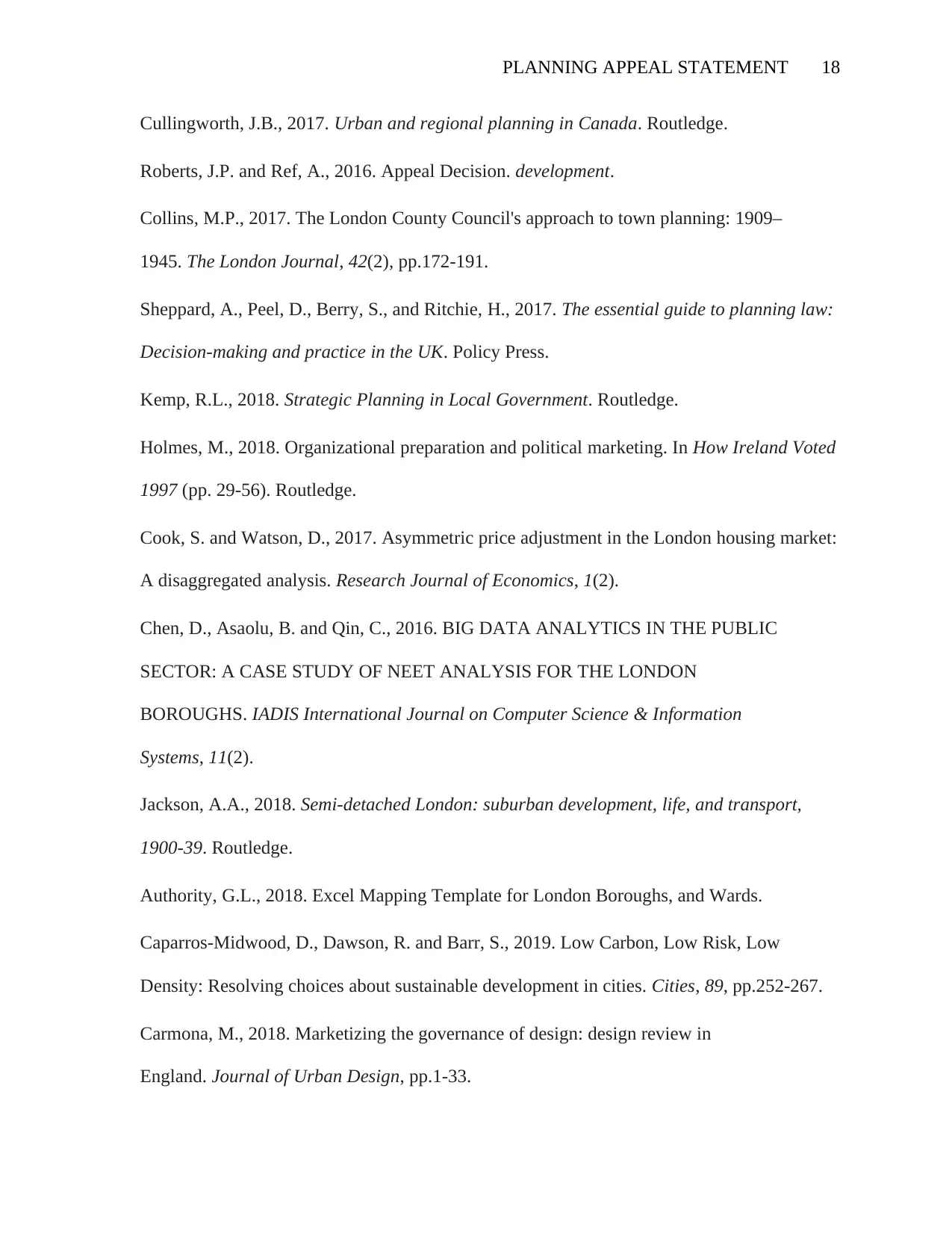
Cullingworth, J.B., 2017. Urban and regional planning in Canada. Routledge.
Roberts, J.P. and Ref, A., 2016. Appeal Decision. development.
Collins, M.P., 2017. The London County Council's approach to town planning: 1909–
1945. The London Journal, 42(2), pp.172-191.
Sheppard, A., Peel, D., Berry, S., and Ritchie, H., 2017. The essential guide to planning law:
Decision-making and practice in the UK. Policy Press.
Kemp, R.L., 2018. Strategic Planning in Local Government. Routledge.
Holmes, M., 2018. Organizational preparation and political marketing. In How Ireland Voted
1997 (pp. 29-56). Routledge.
Cook, S. and Watson, D., 2017. Asymmetric price adjustment in the London housing market:
A disaggregated analysis. Research Journal of Economics, 1(2).
Chen, D., Asaolu, B. and Qin, C., 2016. BIG DATA ANALYTICS IN THE PUBLIC
SECTOR: A CASE STUDY OF NEET ANALYSIS FOR THE LONDON
BOROUGHS. IADIS International Journal on Computer Science & Information
Systems, 11(2).
Jackson, A.A., 2018. Semi-detached London: suburban development, life, and transport,
1900-39. Routledge.
Authority, G.L., 2018. Excel Mapping Template for London Boroughs, and Wards.
Caparros-Midwood, D., Dawson, R. and Barr, S., 2019. Low Carbon, Low Risk, Low
Density: Resolving choices about sustainable development in cities. Cities, 89, pp.252-267.
Carmona, M., 2018. Marketizing the governance of design: design review in
England. Journal of Urban Design, pp.1-33.
⊘ This is a preview!⊘
Do you want full access?
Subscribe today to unlock all pages.

Trusted by 1+ million students worldwide
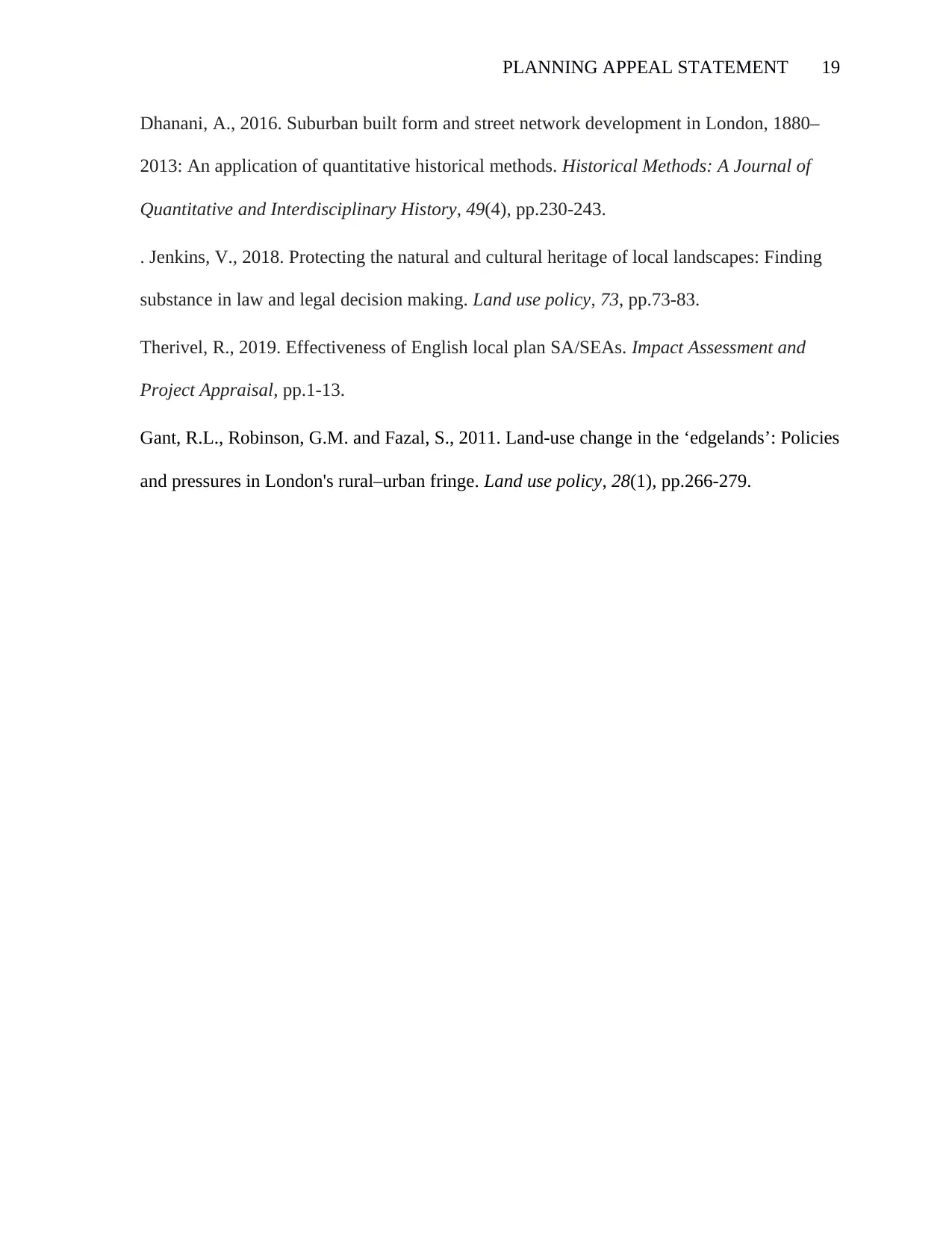
Dhanani, A., 2016. Suburban built form and street network development in London, 1880–
2013: An application of quantitative historical methods. Historical Methods: A Journal of
Quantitative and Interdisciplinary History, 49(4), pp.230-243.
. Jenkins, V., 2018. Protecting the natural and cultural heritage of local landscapes: Finding
substance in law and legal decision making. Land use policy, 73, pp.73-83.
Therivel, R., 2019. Effectiveness of English local plan SA/SEAs. Impact Assessment and
Project Appraisal, pp.1-13.
Gant, R.L., Robinson, G.M. and Fazal, S., 2011. Land-use change in the ‘edgelands’: Policies
and pressures in London's rural–urban fringe. Land use policy, 28(1), pp.266-279.
Paraphrase This Document
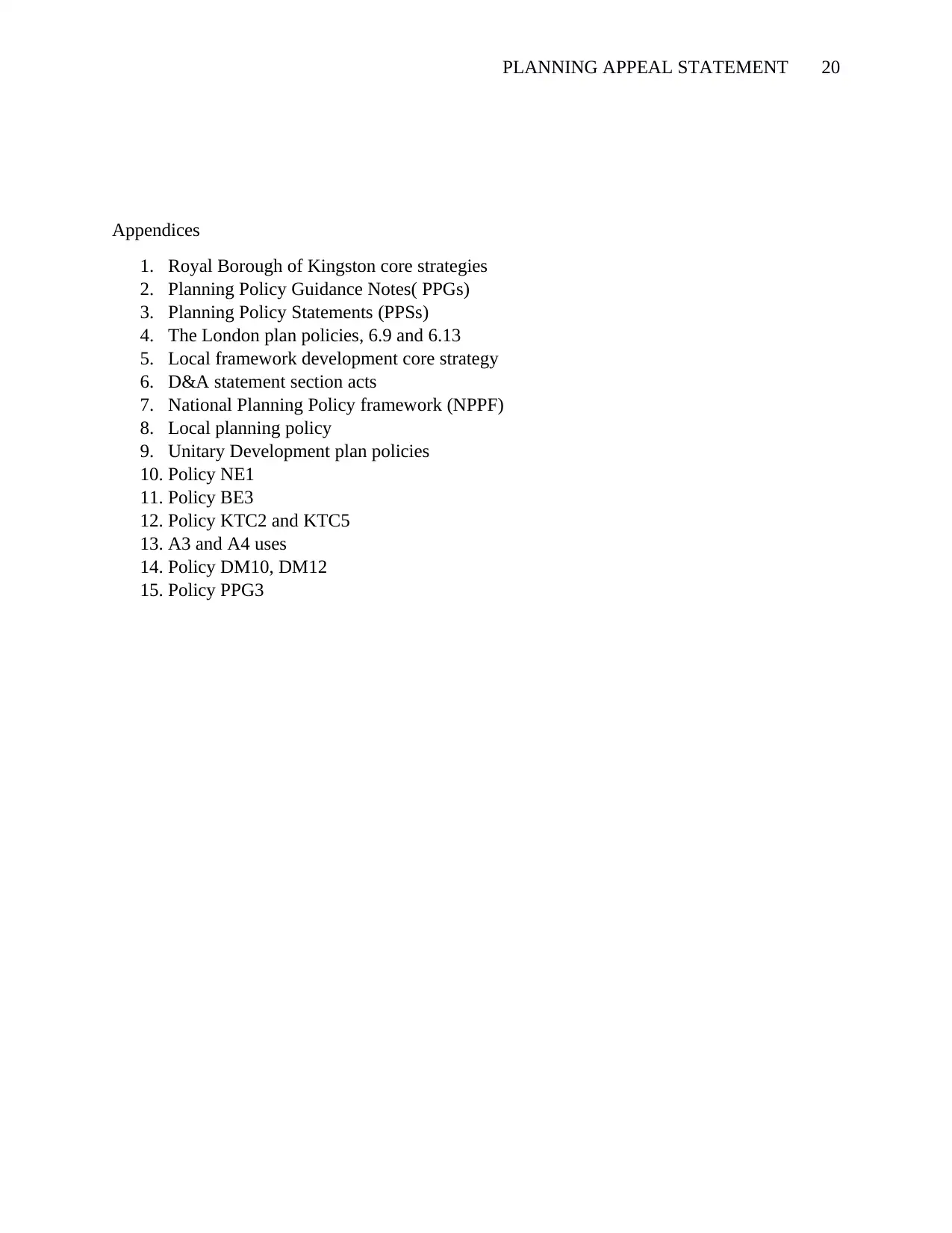
Appendices
1. Royal Borough of Kingston core strategies
2. Planning Policy Guidance Notes( PPGs)
3. Planning Policy Statements (PPSs)
4. The London plan policies, 6.9 and 6.13
5. Local framework development core strategy
6. D&A statement section acts
7. National Planning Policy framework (NPPF)
8. Local planning policy
9. Unitary Development plan policies
10. Policy NE1
11. Policy BE3
12. Policy KTC2 and KTC5
13. A3 and A4 uses
14. Policy DM10, DM12
15. Policy PPG3
Your All-in-One AI-Powered Toolkit for Academic Success.
+13062052269
info@desklib.com
Available 24*7 on WhatsApp / Email
![[object Object]](/_next/static/media/star-bottom.7253800d.svg)
© 2024 | Zucol Services PVT LTD | All rights reserved.
